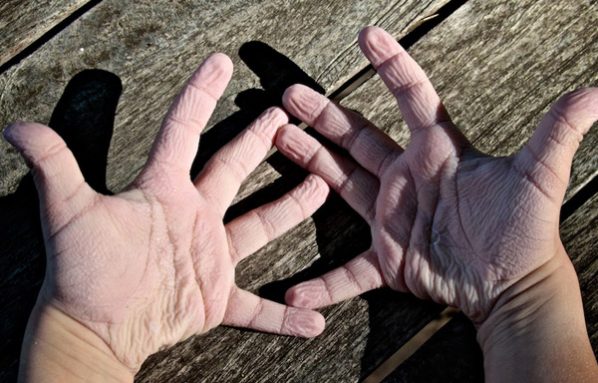Getting a grip
Wrinkled fingers seem to be an advantage in wet environments

If you spend enough time in a pool or bathtub, the skin on your fingers shrivels like a prune. It happens on your toes, too. Some researchers now suspect that this wrinkling of our digits may offer a survival advantage.
The tread on a tire — a pattern of ridges and grooves — helps rolling rubber hold fast to wet pavement. The ridges direct water into narrow grooves, away from where the rubber meets the road. The tread on a shoe works in the same way.
In 2011, scientists suggested prunelike skin might work much the same way. The body’s nervous system — a network of cells used by the brain to send and receive signals to different parts of the body — controls skin wrinkling. If the brain directs skin to become prunelike, those wrinkles must provide some advantage. Or so reasoned the researchers.
In recent tests, scientists from Newcastle University in England confirmed there is a benefit to those clammy skin ridges. Experiments show the wrinkles improve our fingers’ ability to grasp wet, slippery objects.
The Newcastle researchers recruited 20 volunteers. Each individual had to handle a variety of small objects, including glass marbles and small fishing weights. The scientists timed how long it took each person to move the objects from a water-filled container to a dry one. They then timed how long it took each person to move the objects from one dry container to another. The recruits performed each action twice: Once with dry fingers and once with wrinkled fingers. (To get pruney fingers, volunteers soaked their fingers in warm water for 30 minutes.)
Some people worked faster than others. But every participant moved the wet objects faster with wrinkled fingers. Wrinkled skin didn’t help anyone move the dry objects any faster.
These observations still don’t confirm why prunelike fingers grip better. The wrinkles may function like tire treads. There could be other explanations, however, “such as stickiness,” says Mark Changizi. He’s a neurobiologist at 2AI Labs in Boise, Idaho. He led the 2011 team of researchers that first suggested the wrinkles direct water like treads. As a neurobiologist, Changizi studies the workings of the nervous system, which includes the brain and all of the nerves in the body.
More studies are needed to understand skin wrinkling and whether it has any disadvantage. (Otherwise, why isn’t our skin wrinkled all the time?) And scientists are curious whether other animals have this reaction to immersing their digits in water. After all, if humans have this quirk, perhaps other animals do too.
Power Words
nervous system The network of nerve cells and fibers that transmits nerve impulses between parts of the body and the brain.
neurobiology The study of the cells and functions in the nervous system.
nerve A whitish fiber or bundle of fibers that transmits impulses of sensation to the brain or spinal cord, and impulses from these parts of the body to the muscles and organs.







